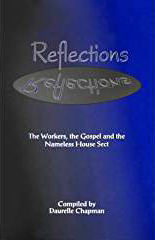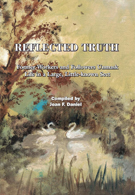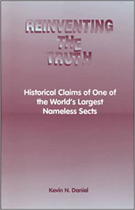From: “The Challenge”
A Dutch Evangelical Magazine [“Uitdaging"]
Postbus 2101, 7420 ZC Deventer, The Netherlands
Issue: December 2005
Two by Two Movement with Sectarian Characteristics
By Jildert de Boer
A simple note in the mail box, a small advertisement in a house to house newspaper, a direct invitation. It concerns an evangelisation service in a rented room, where two persons will speak. It seems that it is not linked to some denomination. You decide to go there to hear what these people will tell from the Bible.
The program is simple. They sing from their own book of hymns with a melody sounding like the style of Johannes de Heer. There is little accompaniment; at the most an organ or a piano. People in the room are not dressed fashionably. The women wear long hair put up.
Two workers are in charge of the whole meeting, in prayer and in speaking a message from the Bible. Things are brought forward about following Jesus, and that few people nowadays obey him. Self denial and willingness to go the way of Jesus and listening to the voice of God are also spoken about. The seriousness of a life with God is emphasised and that this means that you become completely different from the world; and also different than the masses of the religious world. If not, then it is possible to be forever lost.
At a superficial level, it does not sound bad. Biblically, there is little to comment on, and things are discussed that you hardly hear spoken of in many other churches. The quietness, seriousness and respect of the people leaves an impression.
Making a conversation afterwards is not easy. The group disburses quite fast. They steer away from any questions. Meanwhile you notice, however, that the workers are not favorable toward the mainstream form of Christianity with church buildings and pastors.
The evangelical groups are considered to be superficial and “like the world.” The followers of the movement live simply. They do not lecture. A written question to receive more information leads nowhere. “We only have the Bible.” Actually, they also have their own hymn book, “A Hymn For Each Day,” but that is not freely available.
Concerning this movement, next to nothing has been written in the Dutch language area; therefore, we would like to give some information and instructions.
In Holland, at Putten, at the address Voorthuizerstraat 166 behind the house with the placard “the port,” they hold an annual conference. A large tent is erected there and in two conference periods of four days each, the “friends of the way” meet (that is how they refer to themselves) from all over the Netherlands. The tent can accommodate about 400 people. It is estimated that about 1,000 people are involved in this movement in the Netherlands. The movement is considerably “ageing,” and not many children or youth are seen.
In their house meetings, groups of around 8 up to 12 persons meet. If the workers are present in the meeting, they guide the meeting and speak there. The friends take part at the meetings by praying aloud, singing hymns and giving a short testimony. If there are no workers present in a meeting in the home, the assigned elder leads the meeting.
They celebrate communion every Sunday. The “communion” is only accessible for baptised members. Baptism by immersion takes place during the conference time by the workers. They do not baptise infants, do not baptise by sprinkling and do not accept any baptisms by immersion which have been executed in another group or community.
For people with interest in the message, the workers proclaim as the truth, the point of necessary rebaptism is a breaking point. Confessing the Lord Jesus in this fellowship is also confessing the Way of Jesus by following the workers, because only they proclaim God’s true and correct way.
There is something mysterious about this community. They are generally not inclined to answer questions openly and freely. The friends are mostly shy and refer to their workers as God’s servants and handmaidens. The text is frequently quoted: “How shall they hear without a preacher?...And how shall they preach, except they be sent? As it is written, How beautiful are the feet of them that preach the gospel of peace, and bring glad tidings of good things!” (Rom. 10:14-15).
In practice, it means that you are only a good worker sent by God, if you have been sent out following the Two by Two method without money. They are the chosen workers of God who bring souls to belief, which hear the Word by means of these living witnesses’ testimony.
Their sectarian character is revealed when the Two by Two workers do not accept it as a “real” [genuine] conversion when someone reaches faith in Christ by means of a preacher or evangelist from any other church or community. They consider it as false or fake, because it happened outside of them, as God's true Two by Two servants.
Also if you claim that you have been touched by God's spirit while reading your Bible and you give your heart and life to Christ and have experienced the rebirth from God, then it is a testimony that is not acceptable for the Two by Two workers, because the living witnesses were not involved.
It is important that you do not only hear the Word by means of their workers, but that you also openly confesses it as truth! They tend to see you as a searching soul, like Cornelius met Peter (Acts10), and believe sincere, honest hearted people will find and meet the workers. The Two by Two brothers do not want to recognise that everyone who does righteousness has been born of God (1 John 2:29). If you point out to them “the vocation to entity” [or “unity”], then they react with: “firstly there is one true ministry, after that there is one true body.” Unfortunately, with this sectarian attitude they isolate themselves from all other sincere Christians.
In the English speaking world much study has been done into the roots of the movement. The group has many nicknames such as “Church Without a Name,” “Two by Twos,” “the Truth,” “Go-Preachers,” “Cooneyites” (after one of their first leaders), and “Christian Convention Church.” Under that last name the community, a leader George Walker registered with the U.S. government in 1942.
Historically, it is a fact that the movement started in North Ireland with William Irvine in 1897. Irvine had a “rebirth” while listening to the preaching of John McNeil in the Presbyterian church of Scotland. Irvine believed he received a “special revelation from Mathew 10” on the way Jesus sent out his disciples. He started an independent movement around 1900. In 1903, one of Irvine's workers started preaching the “living witness” doctrine/teaching for the first time. This is what they called the “Alpha Message.” In the same year the movement spread out to the United States and later to other parts of the world.
In 1923, the first workers came to the Netherlands. They were Frank van der Merwe and Willie Smeenk. In 1930, the first conference was held in Apeldoorn. It is now a worldwide movement and the estimated number of followers is between 600,000 and 1 million people.
In the beginning one could only be a worker if they gave up everything for the gospel. But from 1908, William Irvine permitted there to also be “friends” (with house municipalities) who kept working in the society, and who could serve the workers with their houses and money. This still takes place today. Having no home of their own, the workers move around from house to house staying with their friends, who lend them their cars, allow them to use their computers, and eat meals with them.
The television is considered as worldly and is not permitted among their friends. In practice the workers are maintained by the friends, who regularly provide them with an envelope containing money. In the beginning years it was possible for married people to become workers, but at present the workers are required to live a celibate life. If workers marry, they must stop being workers and continue as “friends” in the community.
In 1914, William Irvine started preaching his special “Omega Message,” which implied that he was one of the two witnesses from Revelation 11. The majority of the movement did not adopt this revelation, and they continued to believe the Alpha Message of Mathew 10. Also in his personal life, Irvine was controversial, having a dominant attitude and some affairs with women.
When Irvine was excommunicated from the movement, a group of people known as the “Message People” kept following him. This “sub-group” never became massive. Even a second sub-group arose around an excommunicated member, who no longer accepted the “living witness” teaching. That was Edward Cooney in 1928.
The Two-by-Two group was and is by far the largest of three groups. Only this group is active in the Netherlands. Head workers in the Netherlands have been Piet Douma and Piet Blokker. One of the four head workers in Europe is Graham Snow, who is jointly responsible for our country.
The Netherlands has been divided in fields for Two-by-Two movement. In each field a worker or a couple of workers is active. In the Netherlands there are approximately twenty worker couples in total. The fact that female workers preach in this movement has raised questions, of course, considering the texts of Paul where he speaks of women being silent and the orthodox appearance of the group. They support this with Acts 2:18 which states: “And on my servants and on my handmaidens I will pour out in those days of my Spirit; and they shall prophesy.”
You might hear the workers say many good and beautiful biblical things and mention the name of Jesus, but the great danger is that the underlying system is not correct. Religious spirits can abuse this. In the movement there sometimes is a legalistic, depressed atmosphere, where you feel if this has been a “revival movement,” then “clotted revival” is the case today. The workers and the friends function as “priests” and laymen. The friends have to submit to the authority of the workers.
In a subtle form the movement carries “traces” of Roman Catholicism, which also knows a separation between the priests and lay people. This Universal Church has raised Mary as a possible “mediator” of Jesus. What do the workers of the Two by Two movement do? They place themselves as a “sole servants” between people and Jesus Christ and through their words you could reach Christ. This is absolutely unbiblical.
Moreover, the workers do not keep themselves completely to the principles of Matthew 10, Mark 6 and Luke 9 and 10. They do not heal the sick and do not expel evil spirits, because they consider charismatic gifts as “gifts that existed in former days.” The basis from where the serva nts’ work lies now is in the homes of the friends where they are housed or staying as a guest for a period.
Can also something be learned from this movement? Yes indeed! People from the large traditional churches can certainly learn something of the small house meetings that are held, according to the principle each time you meet, everyone has something to share (1 Cor.14:26). Evangelical Christians could think a simple form of Christianity is possible, where one is serious about the Word of God, although this movement explains it according to their own insight.
This movement shows a way of being Christian is possible without all kinds of evangelical “music and dancing” [freely translated] and all kinds of external "show" and in "over shouting" instead of supporting music. The simple and uncomplicated way the group meets, can have - compared to many evangelical services - something gracious.
Following Jesus in obedience is strongly emphasised in this movement and that is correct, because “cheap mercy” is widespread in Christianity.
In spite of these good sub-aspects, we must nevertheless assess this Two by Two community as a group with several sectarian characteristics. The worst one is that they have changed salvation in Jesus Christ by itself and that they have combined it with their monopoly position as the servants of God as being the only “agents” to have access to God's “home.”
There seems to be some Two by Two friends and even workers who would like to enlarge the group than include others than just their own Two by Two group, but most workers still defend the “living witness” teaching.
What this community claims is certainly not the most designated “way” for a Christian to go, and one should not just be attracted by the beautiful, biblical sounding language. If one meets this group, careful consideration/a precise test with the bible is necessary, and one should freely ask questions for clarification to workers and friends on the origins and backgrounds of the movement.
The author is an elder of the evangelical church in Harderwijk. He wrote also a
booklet concerning the Two-by-Two movement.
Translated and printed here with Author's Permission.

 REPRESENTING THE LARGEST COLLECTION OF 2X2 HISTORICAL DOCUMENTS ON THE INTERNET
REPRESENTING THE LARGEST COLLECTION OF 2X2 HISTORICAL DOCUMENTS ON THE INTERNET
 Perry, Oklahoma Conv, 1942
Perry, Oklahoma Conv, 1942


